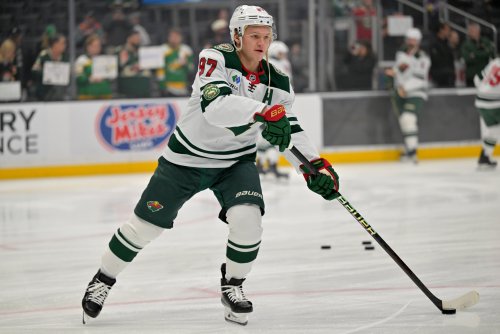
Heading into the season, most everyone felt they had a comfortable handle on who the Minnesota Wild were. They were a team that would probably work hard but also the leading candidate for "mushy middle" status in the NHL. If a UFO descended upon you and said they'd annihilate Earth unless you could correctly pick an NHL team to finish between 11th and 22nd, you'd pick the Wild and feel confident that humanity would see you as a savior for millennia to come.
Seven games into the season, the Wild are still looking for their first regulation loss, and experts are already taking notice. The first edition of The Athletic's Power Rankings dropped today, and Sean Gentille and Dom Luszczyszyn have the Wild third in the NHL, behind only powerhouses in the New York Rangers and Dallas Stars.
"The Wild look like a wagon right now," they say. "[They're] finding the perfect early balance between stout defense and electrifying offense. Well, from their stars, anyway."
Look, power rankings often prioritize the here-and-now and small-sample brilliance early in the season. But the interesting thing is: The Athletic isn't quite doing that here. The 2-4-1 Edmonton Oilers are 11th. The Calgary Flames (5-1-1) and St. Louis Blues (5-3-0) are 16th and 20th, respectively.
So Sean and Dom's rankings aren't about Minnesota's hot start; they reflect a belief that they're good, actually. And since we're about 10% of the way through the Wild's season, maybe it's time to ask if the Wild are better than we thought.
Whenever the Wild are overachieving, the first place you have to look is on defense. It's no surprise to see them at the top of the leaderboard in preventing expected goals. However, it is surprising to see extreme results, even over a small sample.

Several websites grade expected goals slightly differently (as you can see above from HockeyViz), but Evolving-Hockey has Minnesota surrendering just 1.71 expected goals per hour at 5-on-5. They led the league last year, but with 2.24 expected goals allowed per hour, they're about a half-xG per hour tighter than last season. They're also far ahead of the second-place Colorado Avalanche (2.18 xGA/60).
A look at the above heat map shows just how easy they're making life for Filip Gustavsson and Marc-Andre Fleury. This isn't to take any credit away from the goalies -- as they showed last year, you still have to stop the shots that come through, and they've been exceptional early on in the season. As stellar as Fleury was (especially in the first period) in Thursday's game against the Tampa Bay Lightning's skilled shooters, a deeper look shows how clean they kept Fleury's kitchen all night.
Better yet, we're talking about a full team effort. Of the Wild's 21 skaters, 16 allow under two expected goals per game. Only three have given up more expected goals at 5-on-5 than they've generated.
There are a lot of incredible defensive performances to shout out. Still, special attention should be given to Brock Faber, who may just be taking a defensive leap in his sophomore season. Despite one of the heaviest workloads in the league, he's second in the NHL in allowing 1.40 xG per hour at 5-on-5. Marcus Foligno and Yakov Trenin are already proving to be a shutdown winger tandem.
The question is how long things will last. Minnesota has the highest save percentage in the league at 5-on-5, the power play is running at over 30%, and both Kirill Kaprizov's line (18.9%) and Matt Boldy's (14.3%) can't keep up their hot 5-on-5 shooting percentages all year.
The Wild have plenty to fall back on once they start regressing to the mean. They're controlling 56.5% of the expected goal share, and while their power play may not score a goal nearly every game, it was a top-10 unit last year, converting 22.7% of its opportunities. Minnesota is also compensating for its middle-of-the-pack penalty kill by having the second-fewest penalty minutes in the NHL.
But if their defense falls from "historically good" to "simply No. 1 in the NHL," the Wild might be playing with ever-thinner margins. John Hynes has the Wild playing extremely low-event hockey, generating just 2.23 expected goals per hour at 5-on-5. If they can't find more offensive opportunities, they'll be heavily reliant on their goaltending and special teams.
That's a recipe you can win with in the regular season, but is that enough to be a top-5 team in the league? Until we see more from Minnesota -- and that's possible, if Jared Spurgeon and Ryan Hartman return from injury fully healthy and impactful -- it might be just a bit premature to have them among the league's elite.
Think you could write a story like this? Hockey Wilderness wants you to develop your voice, find an audience, and we'll pay you to do it. Just fill out this form.
-
 2
2
-
 1
1






Recommended Comments
Join the conversation
You can post now and register later. If you have an account, sign in now to post with your account.
Note: Your post will require moderator approval before it will be visible.